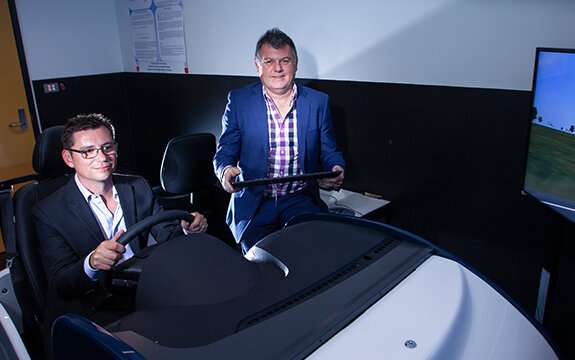Associate Professor Luke Downey and Professor Con Stough using Swinburne's driving simulator. Credit: Swinburne University of Technology
Australians are well aware of the dangers of drink driving. Drinking can reduce your coordination and concentration, reduce your ability to judge speed and distance, and slow your reaction times.
Drugs can have similar effects. With the increased use of drugs in our communities in the past 10 years, drugs have overtaken alcohol as the leading cause of fatal crashes in Australia and in many other countries.
Following on from the successful introduction of random breath testing in Australia to reduce drink driving, research at Swinburne's Drugs and Driving Research Unit helped to enable the introduction of roadside drug testing for the first time in the world.
Swinburne demonstrated the impact of drugs on driver performance, motor vehicle accidents, injury and death. Working with Victoria
Police and VicRoads, Swinburne researchers from psychology, neuroscience and medical disciplines worked together to verify that drivers using cannabis and methamphetamine (speed) had an increased crash risk.
Volunteers were given prescribed doses of cannabis, methamphetamines and other substances, and then their driving performance, cognition and mood was measured under simulated conditions. These drugs were shown to affect a person's ability to drive safely by disrupting normal cognitive behaviour and psychomotor functioning.
The unit, in collaboration with the Victorian Institute of Forensic Medicine, also evaluated the reliability of several commercially available drug testing devices. The research provided evidence that saliva tests could sensitively and reliably detect selected drugs in drivers, and that the saliva testing equipment was suitable for roadside field use.
Swinburne delivered the results of the research in a series of eight technical reports to VicRoads and the Victorian Government. On the basis of this evidence, the Victorian Government amended the Road Safety (Drug Driving) Act 2003 and the Road Safety Act 1986 and later passed the Road Safety (Drugs) Act 2006.
The Road Safety (Drug Driving) Act 2003 was the first legislation of its type to be introduced anywhere in the world. It enabled police to perform roadside saliva testing on drivers for the detection of tetrahydrocannabinol (THC; an active component in cannabis), methamphetamine – including its most potent crystalline form (ice) – and MDMA (ecstasy).
Following Victoria's lead, all jurisdictions in Australia enacted similar legislation (Tasmania and South Australia in 2005; New South Wales in 2006; Western Australia, Queensland and Northern Territory in 2007; Australian Capital Territory in 2010).
Roadside saliva testing was introduced in Victoria in 2004 and the number of drug tests by Victoria Police increased steadily from 735 in 2004 to around 100,000 in 2016. The number of drivers charged with drug-driving offences in Victoria also increased, from 633 in 2010/11 to 5554 in 2015/16 – an increase of almost 900%.
This represents the number of drug-affected drivers that have been detected driving on our roads as a result of Swinburne research. The research has also raised awareness of driving under the influence of drugs and is helping to deter drug-affected people from driving.
Inspector Martin Boorman, Victoria Police, said, "The work Swinburne did with Victoria Police and VicRoads and the role it played in the introduction of the drug- driving enforcement program in Victoria was significant.
Since 2004, road deaths in Victoria have decreased by 25%, representing thousands of lives. This can't be directly attributed to the roadside saliva tests, but it is encouraging to see that the biggest drop has been in drivers under the age of 25 years, which is the group most likely to use drugs.
Swinburne is now recognised as an international expert in this field. Sparked by the outcomes in Australia, roadside drug testing procedures were evaluated across the European Union from 2007 to 2009. Many European countries have since enacted legislation enabling the random drug testing of motorists.
Provided by Swinburne University of Technology






















